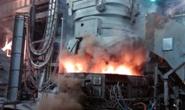Market

October 30, 2014
CMC Profits Double in FY 2014
Written by Sandy Williams
Commercial Metals Company (CMC) reported net earnings of $34.9 million for its fourth quarter ending August 31, 2014. Net sales increased 12 percent year over year to $1.9 billion.
For the full fiscal year 2014, net earnings were 115.6 million on net sales of 7 billion. In comparison, FY 2013 net earnings were 77.3 million on net sales of $6.9 million.
The Americas Recycling segment recorded an adjusted operating loss of $2.1 million for the quarter, compared to an operating loss of $6.7 million in Q4 2013. Net sales were up by 2 percent and 6 percent, respectively, in ferrous and non-ferrous shipments. Stable selling prices and a decrease in average material cost was attributed to the improved performance.
The America mills segment had an adjusted profit of $63.8 million. Shipments increased by 12 percent y/y driven by higher margin finished products. The average metal margin increased 5 percent from the comparable quarter in 2013.
Americas Fabrication adjusted operating profit was $8.1 million, essentially flat with compared with Q4 2013. Shipments increased 17 percent year over year but a $5/short ton decrease in average selling price in tandem with increased input costs resulted in an 8 percent decline in metal margins for the fourth quarter.
Shipments for the International Mill segment fell 11 percent offsetting an increased average selling price of $14 per ton resulting in a $3 million decline to $8 million in adjusted operating profit.
The International Marketing and Distribution segment turned a profit of $13.2 million compared to a loss of $16.2 million in Q42013 that resulted from goodwill charges and restructuring in 2013. European trading remained weak during the fourth quarter.
The following comments were made by CEO Joseph Alvarado in response to question by analysts during the Commercial Metals earnings call.
On imports: “Remember that there are significant lead times on imported product no matter where they might be coming from. This — the whole logistics of entering an order, financing an order, getting it shipped and getting it to someone’s warehouse floor takes a long time. And you might recall, going back 3 or 4 months, that there was significant discrepancy between U.S. pricing and pricing in global markets. So it’s kind of natural that import activity would pick up over time. And as prices decline — I’ll use flat roll and talk about flat roll, which is a more broadly discussed topic. As prices decline, that’s going to squeeze importers and margins to the point where it becomes less prevalent in the market. But you have to watch it over time. And imports are up, and pricing will determine more than anything else the ability of the economy to absorb and for people to speculate on purchasing steel inventories, which obviously has its cascading effect in the production levels. Production levels, overall, still remain fairly flat on a national basis, below 80% of effective capacity. That number hasn’t moved too much despite the gyrations of imports in and out of the market. So I’m not sure I’ve really answered your question much. I just tried to explain that there’s going to be volatility.”
“Our fabrication business remains active, a slight increase in the backlog and better strength all around, at least in terms of bidding activity. But there, too, we’re under pressure from — on margins from imports. And I mentioned that we’re pleased with the results from the ITC decision on Mexico [rebar]. But the Turkish imports are barely touched, with nearly de minimis duties associated with imported Turkish product. And they remain a force, particularly in the Gulf Coast region, which has a tendency to make that business very, very competitive. What we’re doing is being more discerning in markets that are stronger for us, where we can be, where we can differentiate and creating value for our customers. And we prefer that type of business to business that’s strictly based on price.”
On scrap and recycling: As regards to the recycling business, the recycling business is, as you know, a very tough, very competitive business these days. And certainly, there is pressure on scrap pricing as a result of what’s going on globally with iron ore pricing. And I think that’s probably most logically manifested in the level of exports from the United States to foreign shores, whether in Europe or from the West Coast to the Pacific region, in Asia. And so as a result, that’s put downward pressure on prices. And we continue to work hard to improve operating efficiencies and performance. Now there isn’t as much room in conversion costs in a recycling operation as there is in a mill operation, but we’re very aggressive about that. And there’s no doubt that we would benefit from strengthening in prices, and it’s going to be a tough road for us and for all recyclers in the future. And so an important element of our recycling business is that it is our raw material sourcing for our steelmaking business. So unlike some of our competitors, we aren’t looking at it only as a retail business.
On transportation issues: “Yes, we’re concerned about logistics in the U.S. Recent legislation or enactment of laws that make it more difficult for us to secure truck traffic or trailer traffic and time has had an impact. It’s caused our costs to go up. Rails have been more dominated by energy shipments than they have been by other commodities, and that continues. There’s a significant — a dramatically significant increase in the amount of railcars that are being used to transport crude in lieu of the availability of pipeline. So that puts pressure on availability. Ocean-going vessels, there’s ample supply, so that’s not the issue. So yes … it has an impact on all of our costs, whether domestically manufactured or imported.”
On nonresidential construction: “So nonresidential construction specifically, construction spending dollars year-on-year is up about 6%. That’s a significant increase in demand activity. I think the more significant element for us is, referring to an earlier question about the mix, is a shift towards private from public. Public normally requiring longer lead time and longer exposure to fixed-price contracts and the private sector being a little bit shorter lead time and less exposure to fixed-price contracts. So the overall benefit would — is more significant, in my view, in the shift towards more private investment, which is the nonres, away from the public than it is in the overall spend, particularly in markets that we’re serving.”
Andrew Lane of Morningstar Inc, asked the following: “The texture and landscape of the steel industry in the southern United States is undergoing some changes, considering Big River Steel’s market entry, the acquisition of Severstal’s Columbus mill, the impact of Nucor’s DRI project and down the road, U.S. Steel’s changeover to an EAF at Fairfield. So even though you might not necessarily serve the same end markets as these other mills, how do you anticipate these changes will impact your business model with regard to ferrous scrap flows and metal margins?”
Alvarado responded, “My view — we’re speculating on a lot of things that haven’t been authorized yet or approved. And I guess I’d refer to U.S. Steel moving to an electric furnace and the Big River project is still some period away. They’ll, no doubt, have an impact on supply and demand and availability. What I would anticipate is a lot more freight dollars will be spent in the southern states to support the appetite for the electric arc furnaces that are going to be built. There’s certainly ample supply available on a national basis. And then it becomes a function of competing with offshore sources that, at least this year, have declined in their overall demand. And partly, that’s because of availability of products from Asia, in particular, using the example we discussed with — or commented on with Aldo of Chinese billets being made available at very attractive prices, even below the cost to melt in some countries. So there’s no doubt that if all that capacity comes onstream or when it all comes onstream, it’ll tighten up supply and cause more freight costs to be associated with moving scrap to get it to the mouth of the furnace. Hence, our desire to be as self-dependent as possible, and the Newell acquisition fits perfectly with protecting our source of raw material for our Seguin operation.”
The post CMC Profits Double in FY 2014 appeared first on Steel Market Update.






